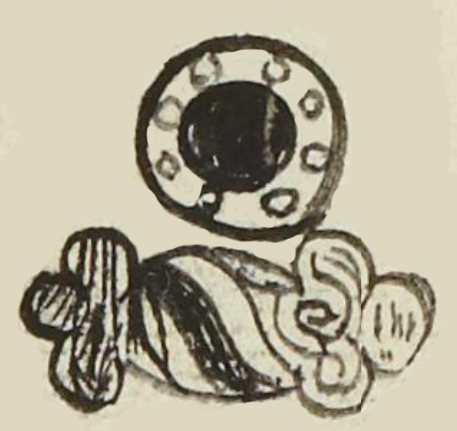de Olmos (MH729r
This black-line drawing of the compound glyph for the personal name de Olmos (a loan from Spanish) is attested here as pertaining to a Nahua man. It shows a stone (tetl) with its alternating dark and light diagonal stripes and curling ends. The stone provides the phonetic indicator for the start to the name “de.” Above the stone is a circle with a dark center, which might be a rubber ball (olli), another phonetic indicator for the start to the surname Ol-. Eight small white circles surround the black ball, fairly evenly spaced, inside the circle. They create something of a border that is reminiscent of a marketplace (tianquiztli). How they play into the name is unclear.
Stephanie Wood
By 1560, the time of this manuscript, a number of Nahua men in Huejotzingo were using the surnames of friars and other Spanish settlers. Fray Andrés de Olmos was probably known among the Nahuas for his evangelical work but also his project in developing a grammar of Nahuatl, the Arte de la lengua mexicana (1547). Many Nahuas were also taking the name Toribio, probably after Fray Toribio de Benavente Motolinia. Even on this folio, there are two men named “Tholipiyo” (a Nahuatlization of Toribio).
Stephanie Wood
1560
Jeff Haskett-Wood
piedras, hule, nombres de hombres, nombres prestados, influencia europea

te(tl), stone, https://nahuatl.wired-humanities.org/content/tetl
ol(li), rubber or rubber ball, https://nahuatl.wired-humanities.org/content/olli
de Olmos
Stephanie Wood
Matrícula de Huexotzinco, folio 729r, World Digital Library, https://www.loc.gov/resource/gdcwdl.wdl_15282/?sp=536&st=image
This manuscript is hosted by the Library of Congress and the World Digital Library; used here with the Creative Commons, “Attribution-NonCommercial-ShareAlike 3.0 License” (CC-BY-NC-SAq 3.0).








